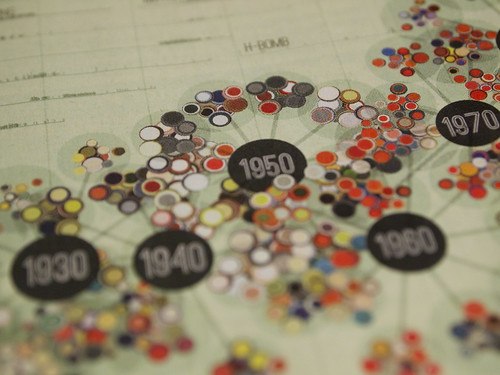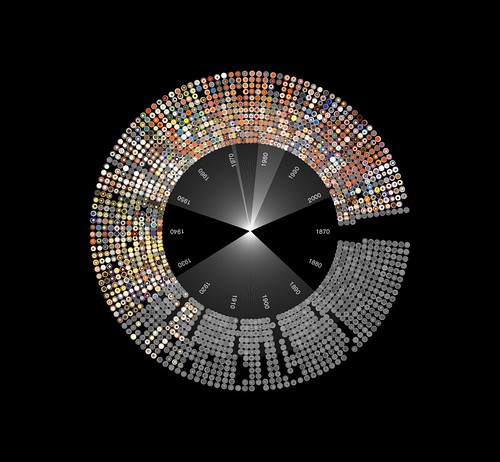Nick Felton // Computational Information Visualization

2014 Annual Report
Nick Felton, or Feltron, is a data visualizer who is known for his personal annual reports of mapping his self-tracked data (how much sleep he gets, how much he codes, where he’s been, how many pictures he’s taken etc.).
I was almost going to write about his annual reports and just how much I appreciate the fact that he has not only visualized data but aesthetically visualized data, but I think this is plain obvious after exploring his website. Feltron has both a code and design sensibility. He’s really the middle man between designers who can’t code and coders who can’t design. Goals.
PhotoViz Book

I then became really interested in PhotoViz, another project that was just released in May 2016 that explores the intersection of photography, infographics, and data visualization. Trying to find out what’s inside the book, I think it’s more of a collection of other people’s work, and I’m not sure if Felton included any of his own projects related to photographic data viz. I’ll have to purchase the book to find out.
What’s fascinating is that with the proliferation of smartphones and thus amateur photographer with selfie taking abilities, people aren’t just taking photos at one decisive moment where they are limited to only 10 shots, they are taking many photos because they have cloud or 128gb of storage and need. There’s even cameras that are persistent cameras, meaning they can take a picture every few minutes for let’s say a month or year. It’s almost like surveillance and it’s meant to document rather than to artistically frame a shot. “In 2015, people around the world took a staggering 1 trillion photographs, according to research firm InfoTrends. By 2017, 4.9 trillion images will be stored online” (source). This opens up a lot of conversations about what to do with all this data and how to tell the story or identity that this data represents.
The overlap between photography and data visualization is blurry, and that’s what PhotoViz is.
photography <———–> data visualization <———–> code
Photography can successfully visualize data, like the cover of the book where all the planes within a 6 hour timeframe fly through LAX, but it isn’t necessarily grounded in code. In fact, the photographer painstakingly photoshopped each airplane. Photomontages of Olympic athletes also help visualize the unseen, the steps that go into a blink of the eye routine. Yet photoshop can also be used or photomontage softwares. Overall, I found a handful of examples of the books that have striking visuals, but I can’t tell which one’s were created through code or by hand, except for Tega Brain’s project. Either way, I think PhotoViz is going to be a thing soon.

Simone Biles Photomontage

365 Selfies, Dylan Mason


Singapore Sunset, 2016

“Since early 2008, roughly 40 million images have been uploaded to Flickr® every month making a rich, ever-growing digital collection that documents a vast range of human experience including our observations of other species. Keeping Time is made from over 5000 of these photos taken during the years 2002-2013.” (Tega Brain)
_____________
More on PhotoViz in this 30 min vid … Nick talks about his conception of Photoviz: here
There was a particular line that Felton said that struck me, “I think of data as the new wood, as a material. Historically designers worked with text and image, but now that’s not enough, you have to play with data. It’s like wood, you can use it in many different and precise ways.”
It made me think about what being a designer will be like in the next 50 years. It used to be the letterpress, and now, it’s data viz, what’s the next medium?

 A visual study from the artist on coherence, plausibility, and shape.
A visual study from the artist on coherence, plausibility, and shape.
 Countries represented by their wellness components.
Countries represented by their wellness components.












 I like his other work too, aesthetically, but 9-Questions is the sort of stuff that gets me going.
I like his other work too, aesthetically, but 9-Questions is the sort of stuff that gets me going.

















 2014 Annual Report
2014 Annual Report

 Simone Biles Photomontage
Simone Biles Photomontage
 365 Selfies, Dylan Mason
365 Selfies, Dylan Mason

 Singapore Sunset, 2016
Singapore Sunset, 2016
 “Since early 2008, roughly 40 million images have been uploaded to Flickr® every month making a rich, ever-growing digital collection that documents a vast range of human experience including our observations of other species. Keeping Time is made from over 5000 of these photos taken during the years 2002-2013.” (Tega Brain)
“Since early 2008, roughly 40 million images have been uploaded to Flickr® every month making a rich, ever-growing digital collection that documents a vast range of human experience including our observations of other species. Keeping Time is made from over 5000 of these photos taken during the years 2002-2013.” (Tega Brain)
